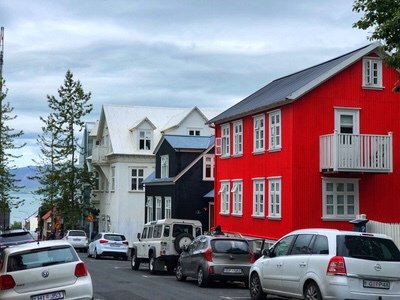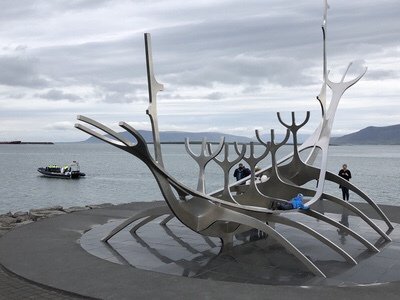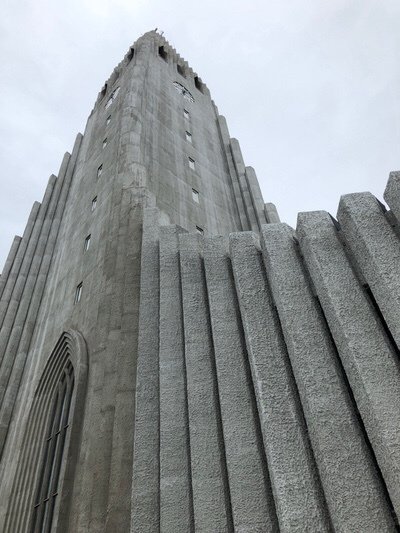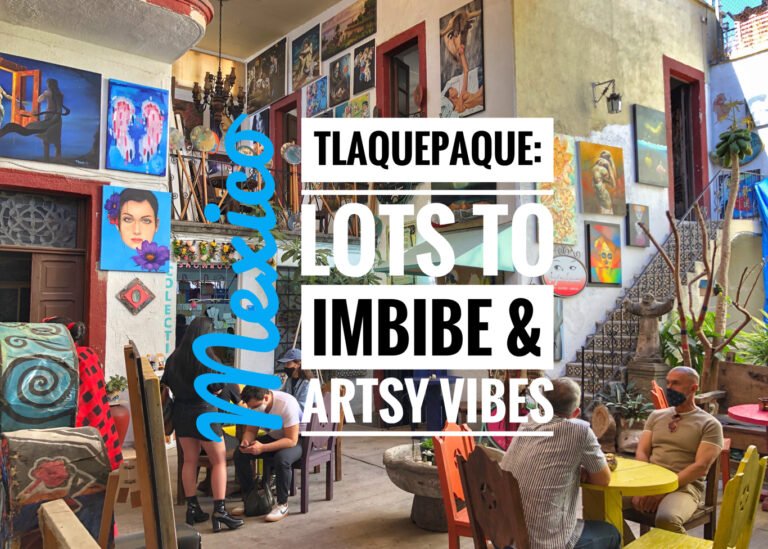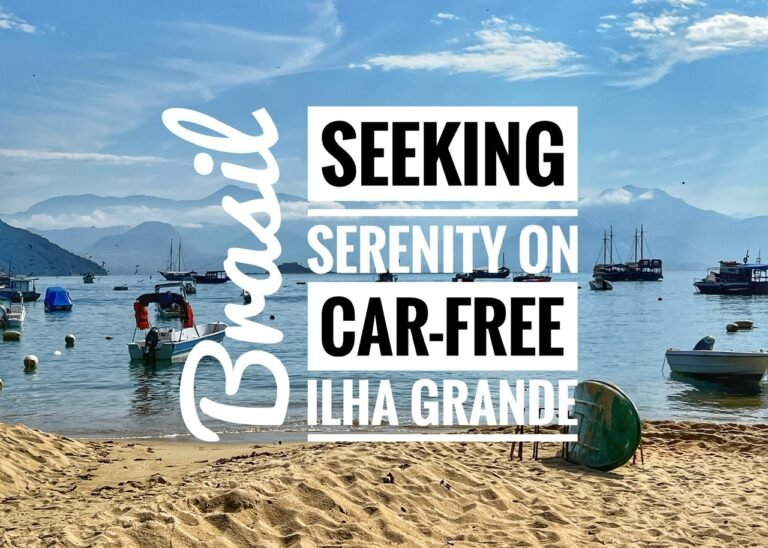
The Earth throws just about every dramatic landscape at you in Iceland; Gushing waterfalls….check. Explosive geysers……check. Volcanoes and steaming fumaroles….check. Glaciers and icebergs… check. Hot springs and bubbling mud pots… check.
Iceland is a country where the earth moves, and moves you. With 30 active volcanoes, and vast glaciers occupying nearly every mountain range, the land of fire and ice is utterly captivating. The stark beauty on display is hard to grasp. Iceland is also a place where legend and fantasy seem to be taken as literal, ingrained into every jaw-dropping natural wonder is a local legend about it. This is a place built for nature lovers and fantasy enthusiasts.
Iceland was an obvious first stop for us as we make our way around the world. In case you didn’t know, Iceland Air offers a layover with flights going to or from the U.S. with no additional costs, just plug in “multi-city flights” into your next booking to Europe (#mystopover). Iceland is rapidly being “discovered” by tourists who are taking advantage of this stopover perk so it’s not as off-the-beaten path as it once was due in the most part to a 2010 ad campaign initiated by the tourism board following a volcanic eruption. The ad campaign was hugely successful and has increased tourism by 30% per year ever since. Fortunately most tourists crowds stick to the vicinity of Reykjavik or to tours which concentrate on The Golden Circle. This means, once you expand your travels outside of these areas the solitude and lonely travels are much easier to come by.

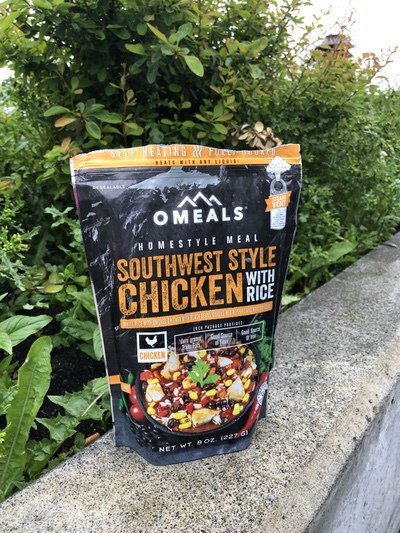

We touched down in Reykjavik barely surviving two back-to-back red eye flights from Portland, including a 15-hour layover in Philadelphia, (the downside of using points to jump across the pond for free). Iceland greeted us with a July temperature of around 55 degrees Fahrenheit (12 Celsius) and a steady drizzle. Puffy coats were on from the moment we exited the airport. Although the weather is usually quite pleasant in the summer months of July and August, the summer of 2018 is appearently ‘exceptional’. One hundred years exception. Two days before our arrival we caught a glimpse of a Guardian newspaper article proclaiming this year to be “the most wintry summer in 100 years.” Apparently it has been virtually non-stop drizzle for months, with the number of dry days being what you could count on one hand!
We had elected to rent a small economy car for our ring road trip… we had booked it nearly 6 months ahead of our trip so we snagged a great rate ($350 USD), then it was off to the least expensive grocery market in Iceland, Bonus (the pink pig). Bonus is a real life saver for the budget traveler in Iceland, buying your foodstuffs there will save you significantly over buying elsewhere. We spent a very reasonable $40 for a good assortment of fruit and veg, eggs, oats, tuna, bread, and propane. So, Look for the pink pig! And, yes they even stock large propane fuel for your camping stove! If you’re trying to do Iceland on a even a modest budget, it will require some serious forethought and planning for your food prep. In our case, we brought nearly all our meals with us from the U.S. in freeze dried pouches made for camping. Fortunately camping is totally the ‘in thing to do’ while traveling in Iceland. Designated campgrounds are sprinkled along the entire Ring Road, in the towns and cities just like hotels, so it just makes sense to plan and pack accordingly, eating as you would if you were on a camping trip.
All stocked up in Reykjavik… we turned and burned (well not exceeding the 90 kmh speed limit of course.) Our 829-mile road trip that would deliciously encircle Iceland was to begin!
For our six days, we opted to head counter-clockwise on the Ring Road, traveling southeast from Reykjavik and onto the so-called Golden Circle portion. This is the most popular, by far, and heavily touristed portion of Iceland. But at only one hours drive from Reykjavik, if you only have 72 hours or less in Iceland it’s an absolute must-do. The sights on the Golden Circle are amazing; just don’t expect a lot of solitude, or alone time to reflect on what you’re seeing.
In our case, we opted for a slight diversion from the official Golden Circle route. After having suffered the two consecutive red eye flights our aching muscles were longing for less time in the car seats and for some movement. So Reykjadalur (Steam) Valley was an easy and optimal first target. Adequately named, the Reykjadalur valley is literally saturated with piping hot steam fissures, boiling springs, mud pots, and a hot river. After a quick, but steep 3K one-way hike past all these geologic oddities, we arrived at our reward, the delightful (yet busy) hot springs thermal river. Well, worth the detour indeed!
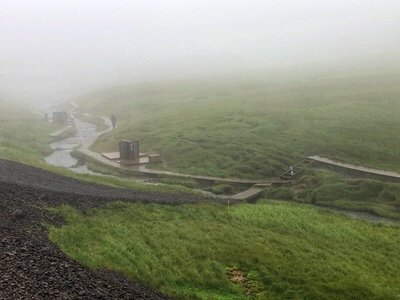
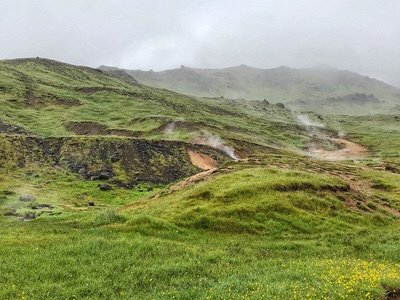
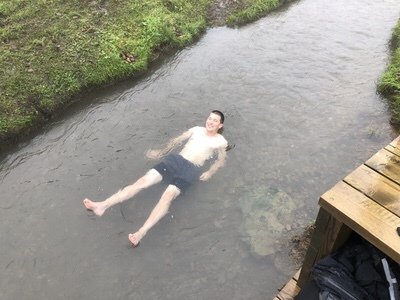
Next stop, Geysir. The Geysir. The English word “geyser” came from this Icelandic word meaning “to gush.” This geyser has been active for approximately 10,000 years, half of the age of Iceland, a geological youngin which just celebrated its 20,000 birthday. Unfortunately Geysir is not currently erupting any longer, but Strokkur (pictured), its attention-grabbing little sibling heaves water 15-20 meters (40-65 ft.) in the air about every 7 minutes. Once it erupts, it leads behind a beautiful trail of mineral rich steaming H2O. It’s easy to see why this is one of Iceland’s “hot spots” to visit. (Pun intended.)
Continuing on the Golden Circle, we came next to Gulfoss Waterfall, a perfect show-stopping “starter” waterfall for us (with an estimated 10,000+ waterfalls in Iceland, it is a waterfall lovers dream destination!) Gulfoss is a tremendously huge volume of water thrashing its way over two consecutive drops and down into a huge crevice in the Earth’s crust. The flow of water seems truly paradoxical, as it extends perpendicularly to the flow of the river. In a country where 100% of electricity production comes from renewables, it is no surprise that this waterfall was at one point “rented” by foreign investors in the early 20th Century intent on harnessing the falls power with hydroelectricity. Fortunately, the investors’ attempts to dam the falls were unsuccessful and this wonder of nature it is now protected.

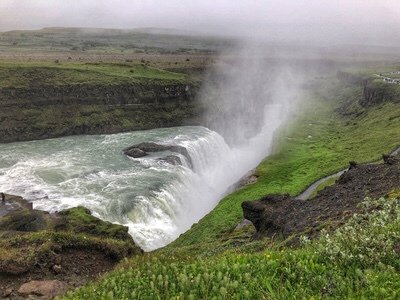
After driving all day, we decided to put down our tent stakes and camp at the Smaratun Guesthouse, about a 1.5 hour drive from Gulfoss. The ceaseless rain did not make the decision to camp any easier, but we couldn’t very well blow our weeks budget on the first night by staying indoors, on a comfy and cozy bed in a guesthouse. So, we zipped up our rain coats and grunted and huffed our way through putting up our lone tent in the small but quite nice camping area provided by the Smaratun Guesthouse and farm for the bargain price of $26. Pretty much the average price you will pay for a campsite in Iceland, and about 1/3 what you would pay for a bed in a hostel for two people. Camping is the obvious budget choice for those on a budget. Fortunately, the campsite also included access to the kitchen, and to a hot shower (!) both of which made our night camping in the cold rain substantially more bearable.
Oh, and also, just a note, for those who have never tried sleeping when in a place that has the midnight sun… it’s a treat. Eye masks are totally obligatory accessories for summers spent camping in Iceland.
Day two morning, waterfall number two, Seljalandsfoss (is Icelandic getting easier?) was loaded with people toting selfie sticks. But, despite the crowds, this waterfall is impressive for the fact that it is one of the few you actually can walk behind. This is a treat, for sure! It was also featured in season six of the Amazing Race, as well as a Justin Bieber video. We promise we only know this due to Wikipedia.
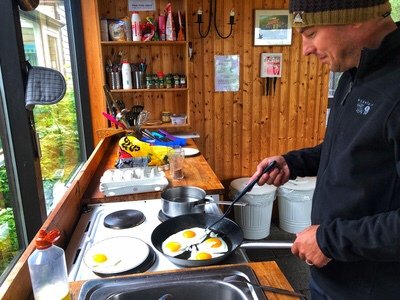

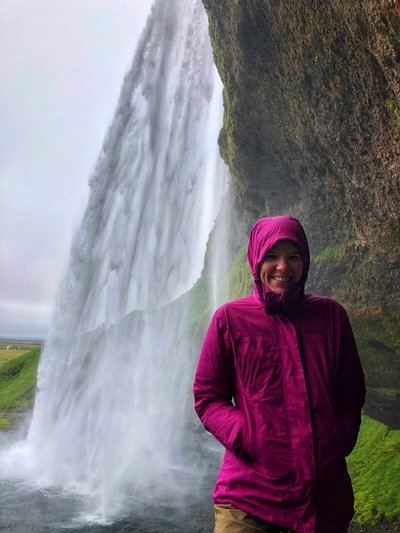
From this point, it was time to begin making-our-own adventure and leave the crowds behind. While driving the Ring Road, we suddenly spotted a quaint little church off in the distance, tucked into a small village of about 10 houses and farms. We pulled off the paved road onto gravel. The town, Asolfsskali was a farm village at the foothills of Mts. Eyjafjoll. Later we learned that according to The Book of Settlements (the official medieval Icelandic written work which describes the settlement of Iceland by the Norse in the 9th & 10th Centuries), an Irish Christian build the first lodgings here. Most people think the Vikings were some of the first in Iceland, but in fact the Irish Monks came first. The Vikings came in 796-1066, capturing monasteries and slaughtering the monks. The swiftness and extent of the raids were what gave the Vikings their barbaric name, but the actions were in actuality the “standard of the day.” And really? We think the world is so terrible now? In Asolfsskali, we stumbled upon our first turf house, picturesque church and traditional cemetery. Also, there was an adorable cottage for those who wish to avoid sleeping outside in the rain.



After driving the Ring Road during day two we suddenly began to wonder why are there so few trees in Iceland? Trees are not totally absent from the landscape, but those which are there all seem to be less than 20 feet high. It really struck us as odd, the more we thought about it. There is lots of wood used for building and equipment in Iceland, but only spindly shrub trees occupy the landscape. After some research we found a startling answer to our wondering about the trees… the Vikings actually razed the entire island of its trees about 1000 years ago, and despite years of effort to replant the forests that once existed there, it seems very difficult to get them to return because of the harsh climate.
Vikings, by the way, were also responsible for naming Iceland. Even though, it’s clearly quite green and lush, they cleverly named the island Iceland to deter their enemies from pursuing them. They sent word back to Norway that their island was actually an ice-land, but another more distant, and a more distant, larger island was green. Hence, Greenland.
Our next stop, Skogafoss, proved very barren but daunting. This waterfall used to be at the cliff of a former coastline. After the coastline receded seaward about three miles it created a clear border between the coastal lowlands and highlands of Iceland. An impressive 500+ stairs wind up to the top, to a view of the 200-foot drop. As you can see, there is also an option to camp near the base… this has to be one of the more epic camping spots in Iceland.
We found our ideal lunch spot for the day near Dyrholaey, a remarkable black sand beach and shoreline with swooping lava arches and basalt rock columns that stretch right to the ocean near the town of Vik. It is said that in the summertime, puffins like to hang out near these rocks, but they chose to disappoint us on the day we went.

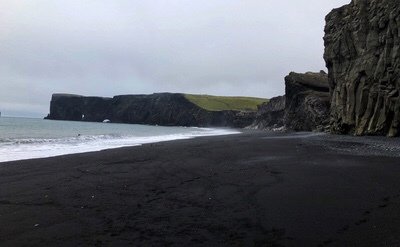
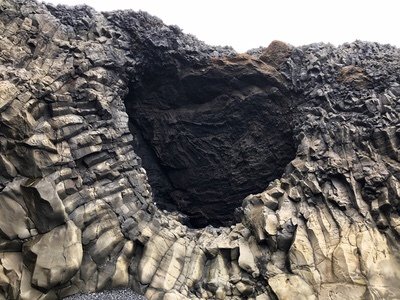
Continuing to drive on the Ring Road, we headed east and encountered the most unusual terrain we’ve ever seen… located on the Eldhraun lava field. A bright and brilliant green undulating blanket lays across the landscape. Thick green moss which covers the lava rock disguises what lay underneath with a pillowy and delightfully spongy surface. Like walking on clouds of green cotton several feet thick… it was remarkable to be immersed is such a bizarre landscape. The lava the moss covers was created due to one of the most devastating eruptions in recorded history in 1783, which wiped out nearly a quarter of country’s population.
After climbing all of those stairs at Skogafoss, and consuming lots of delicious glacier-fed Iceland tap water (free everywhere! Don’t forget a water bottle!) we came upon a loo we desperately needed. But, not so fast, don’t forget your credit card (yes, the loo is unattended in Iceland and takes credit cards) because that’ll be 200ISK (or $2) for a pee. We didn’t even want to consider what a #2 might’ve cost us!

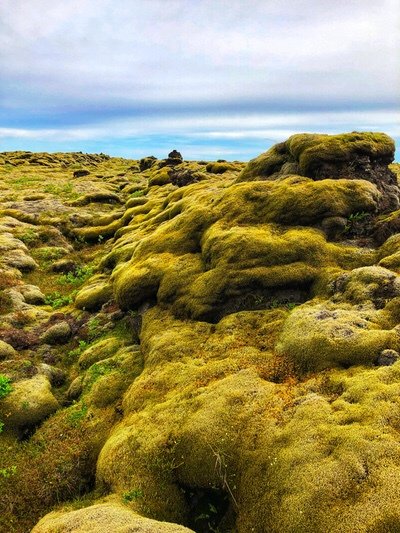
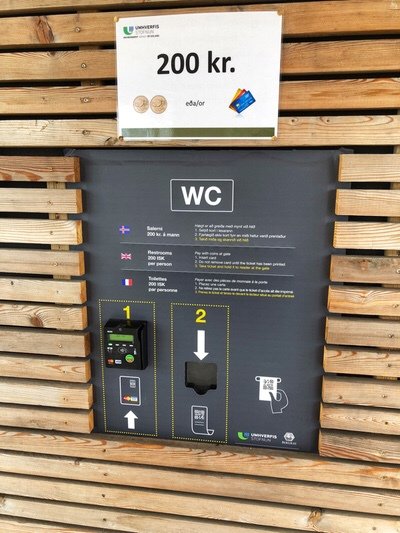
Pulling over into the next village on our Ring Road route, Hof, we found our first turf church, Hofskirkja. Skirkja means church, Hof is the town—so you guessed it, Church of Hof. (See Icelandic is totally easy!) Iceland is home to a unique building technique using turf for roofing and insulation from the bitter elements. The church pictured is from 1884 and was the last church built in this style in Iceland. It lies on the Ring Road between the towns of Hof and Hofn. Note the lumpy ground surrounding the church. These were the graves… So much for 6 feet under.

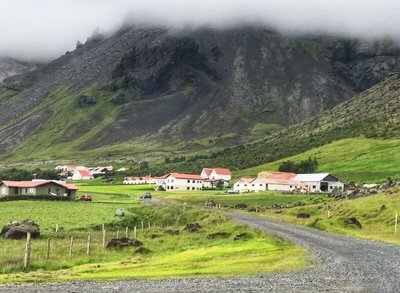

Down the road from the turf church we came upon another truly remarkable, pair of jaw dropping Iceland experiences. The otherworldly Jokulsarlon Glacier, and it’s accompanying Diamond Beach—both strikingly surreal natural wonders. Jokulsarlon is a glacial lagoon bordering Vatnajokull National Park. It’s still icy sapphire waters and luminous blue icebergs are fed from the Vatnajokull Glacier. It developed into the lake after the glacier started receding from the edge of the Atlantic Ocean and has grown at varying rates because of melting glaciers. There is now a .9 mile river that connects the lake and ocean and because of this, chunks of ice flow from the lake to the ocean and deposit “diamonds” magically all over the beach, yes…Diamond…Beach. Seeing crystal clear chunks and blocks of glacial ice set against a coal black beach definitely makes you suspect fantastical things might really be possible in such a magical land like Iceland. You simply can’t prepare yourself for seeing a wonder of nature like this place. Hollywood must think so too. It has used this location for Lara Croft: Tomb Raider, Batman Begins and several other movies.
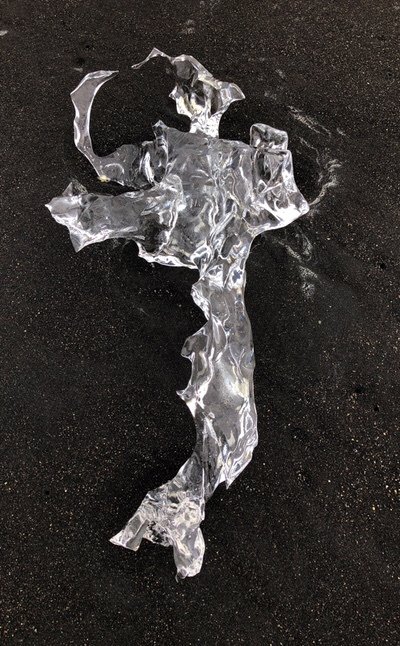



The campground in the town of Hofn ($30, and the most expensive of our trip) proved to be a very popular option for other Ring Roaders, with our tent sandwiched in amoung many others… our neighbors about three feet on all sides. The next morning we headed out again, continuing east (counterclockwise on the Ring Road) with the forecasted promise of sunshine which we had heard from two sources (optimistic locals, as well as our weather app.) But, alas, the clouds did lift! And we rejoiced! This is no embellishment… when the sun came out, Iceland suddenly went from beautiful to absolutely stunning. We could see up the mountain sides more than 200 feet, and see miles away! Every bend in the road was now a fresh surprise—waterfalls leapt off the cliffs and tumbled from high up, mountaintops were visible to gawk at and appeared everywhere, and the air became crisp and refreshing.
From Hofn we made our way into “Fjord Country” up to the village of (a place name that just rolls off the tongue), Seyoisfjordur. Only a 25 km detour from the Ring Road, Seyoisfjordur is absolutely worth the detour. Once turning off the Ring Road from Egilsstadir, you ascend a mountain almost immediately, encountering serene lakes, waterfalls and pullouts along the very steep ascent. Once you crest the mountain and you begin your descent, and you get your first glimpse of Seyoisfjordur… a picturesque village lying in the throat of a massive fjord of the same name.
This village oozes the appeal of small-town Iceland with a population of just 665. It is a treat to stroll around in, especially if the sun is shining. Settlement traces back to 8th Century, but the town itself was settled in 1848. During the war, it was used as a British/American army base, and there are still remnants of this, but its economy is now mostly tourism. Like much of Scandinavia, the Icelandic people are incredibly kind and welcoming to all people and have a progressive view. This can be seen in the symbolically painted road leading up to its main church. 71% of its people are Lutherans.
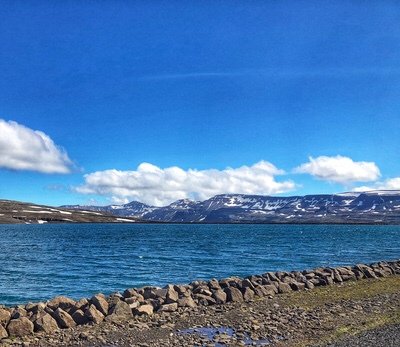



After a lovely visit to the eastern fjords and Seyoisfjordur, we were again on the Ring Road rounding the corner to turn northward, on our way to our next big stop, the Dettifoss waterfall. This waterfall is said to be the most powerful in Europe with a volume of 500 cubic meters per second plunging over the edge. It is 45 meters high and 100 meters wide and frequently casts a double rainbow over its raging waters. There are two sides to enter. One is paved, where the tour buses go, and the other is gravel and requires 4×4. We did not have a 4×4 (obviously…you saw the picture, right?) so we stuck with the tourist side.
Also nearby, we were surprised with the opportunity to do some washing up at this literal hot springs shower (below, right) in the middle of nowhere on the way to Krafla Crater (not pictured) from Dettifoss. It has a fully operational, ever-lasting hot shower and sink. Sorry, ladies, no mirror for extra primping, but it did the job and was quite entertaining. Only in Iceland…
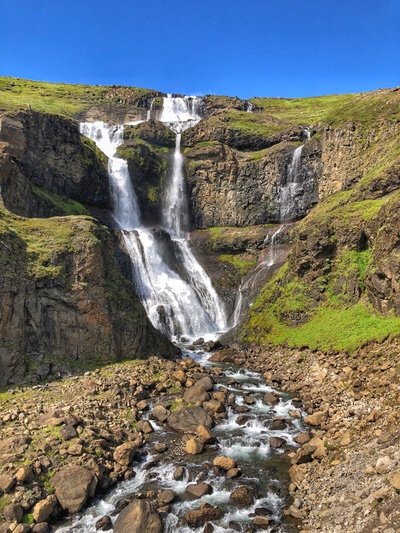


After our shower, we needed a good steam so we headed to the mystical world of Hverir, a lunar-like landscape where geology cannot get more raw. Hverir is filled with belching mud cauldrons, steaming vents, and spouting fumaroles. Although the sulfur smell was overpowering, it was an utterly unique experience to glide through the steam and feel the raw warmth of the earth while a soundtrack of gurgling and spurting reminds you how bizarre the Earth’s forces can be. Interestingly, it’s said that the fumeroles here can act as a natural nebulizer and can help fight illness.


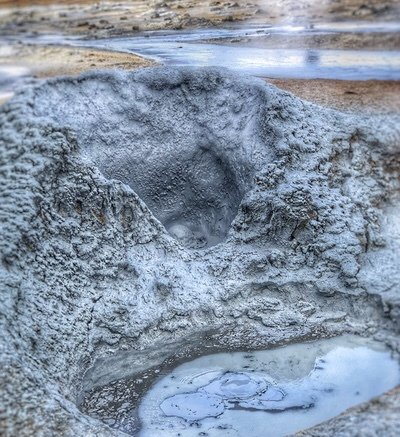
After the natural offerings on display at Hverir, we were due for total immersion into an actual bath and steam. Just up the hill, lies northern Iceland’s Mytvan Nature Baths, which is a much less crowded, cheaper and comparable alternative to the Blue Lagoon. Still a bit of a splurge at $50/person for us, this alkaline milky blue bathing lagoon backed by volcanic rock is truly a blissful experience, and at a 100-104 degrees Fahrenheit (38-40 Celsius), two large pools and hot water spouts. There are also two steam rooms with geothermal steam rising through floor vents. A restaurant is also available to purchase drinks from, but at $15 a pop, we chose the more practical free and super tasty glacial water. (After all, you can pay $4 for Icelandic bottled water in the States!)
Wrapping up day three after the Mytvan Baths, Greg shows you how much progress we’d made so far on our Ring Road adventure (below, right) before we made camp at Lifsmotun Camping Farm, which was wonderfully empty, remote, and quiet. Tomorrow …to the Arctic…

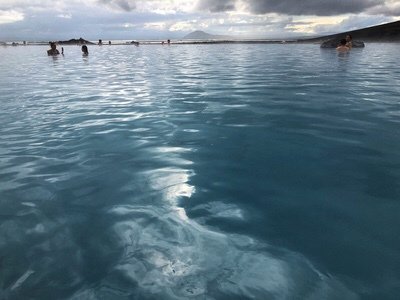
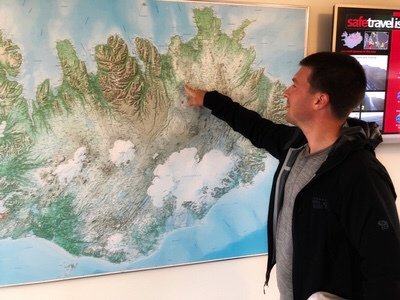
The next morning, before heading north we backtracked slightly to Reykhalio, which is simply saturated with incredible offerings. On the way, we finally got a terrific sheep shot. Let’s talk about sheep. There are estimated to be 481K sheep on the island. There are 334K people. These sheep are predominately raised for meat, so vegetarians, if you tuck one in your backpack on the way out, they might not notice. Good news is there are no hormones used in Iceland and everyone gets to graze freely, so at least that’s something.
Next stop, one of the most breathtaking waterfalls yet—Godafoss, waterfall of the gods. It’s not a super tall or powerful waterfall, but its separate cascades form an elegant semi-circle and make it one of the most captivating, at least for us. Also, due to the lava rocks surrounding it, it’s easy to walk out to the edge and sit right next to the plunging force. Godafoss is closely connected with one of the most important events in Icelandic history—the conversion to Christianity from “heathendom” in the year 1000. In 1000, Thorgeir Thorkelsson, the Speaker of the Icelandic parliament and a pagan priest and chieftain, decided in favor of Christianity after a day and night of silent meditation under a fur blanket. After deciding this for an entire country, he himself became Christian and symbolically through his former gods off the waterfall as a symbolic act of conversion.
The liquid sunshine continued to gloriously fall upon us so set out for the Storagja Caves—an ancient subterranean cavern complex known for its geometric rock formations and hot spring caves. We thought we were just going for a gentle stroll among rock features and caves, until Greg spotted a rope going down into a small cravass… upon closer inspection we had unknowingly discovered a hot springs pool inside the cave. Hot springs are obviously a dime a dozen in Iceland, but finding one that’s Goldilocks—“just right”—not too hot or not too cold can be a little challenging. Unfortunately our first hot pool discovery was just shy of luke warm, and not quite dippable. We did finally find one that was, and this one came with a ladder to climb down into the pool. Warmer, but not quite hot enough for the “oh-my-god” effect, this hot spring was still incredible because, one, we were alone here and two, it’s deep water so you can swim! Oh, and you’re in a beautiful cave! To find the hot pools from the trail simply do have to look around for the rope and ladders which descend into the caves.

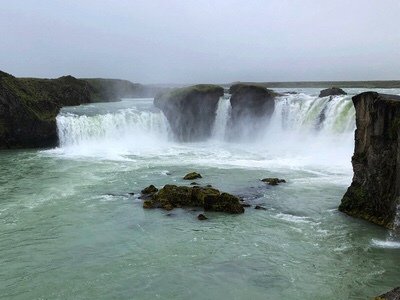


Arctic bound now… to the hidden gem of the north… the Trolliskagi Peninsula, which you guessed it, means “Peninsula of the Troll.” Unfortunately the trolls did not come out to play for our visit, but it’s easy to see why they settled here. The detour off the Ring Road up and around the Peninsula took about three hours with short stopovers. We are so glad we made this detour however, because it was a treasure for the senses with breathtaking wild and remote landscapes, rolling mountains and lush green valley landscapes, tiny (still) secluded and untouristed villages with miles tunnels (often single car width two-way with pull-outs used to prevent head-on collisions) to connect them.
This most intense tunnel is the one that spits you out at the village of Olafsfjordur, population 824, a tiny fishing village set in deep mountains with a history of isolation from the rest of the world, at least until these tunnels came to be. It’s a very popular place for skiing and northern lights viewing. Of course, the midnight sun did not permit us to see those!
The next village, Siglufjordur, also known as the northernmost town in Iceland, was equally as charming. This former herring fishing village once had a population of 3,000 but has dwindled to 1,200 and now relies on other types of fishing for its main industry. Both towns were well worth a stroll through, despite the consistent rainfall.
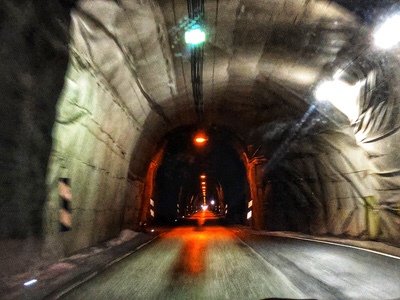
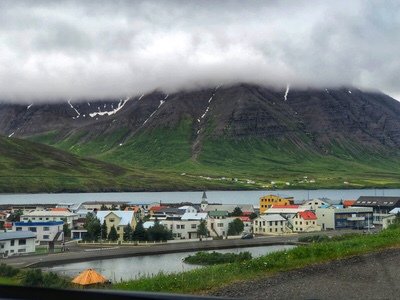

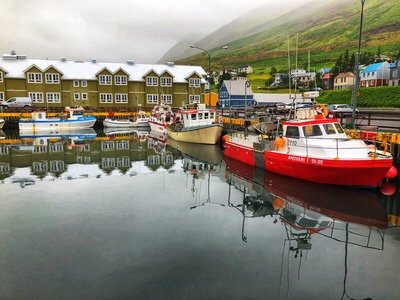
We made it to the tip of the peninsula on the Arctic Bow (the road’s name), where we were were a stone’s throw from the Arctic Circle at 66 degrees north latitude and the Trolliskagi Lighthouse. (For the record, you can visit the Arctic Circle in Iceland on nearby Grimsey Island, but this requires a ferry ride with a hefty ferry fee.) For us, the fiery orange lighthouse, which created a brilliant pop against the gloomy greyscape, would have to do.
But, after a night spent camping nearby in the village of Hofsos, in 40 degree Fahrenheit temperatures, we were gifted something amazing in the morning when we awoke….SUN! And it lasted the entire day! What a wonder!
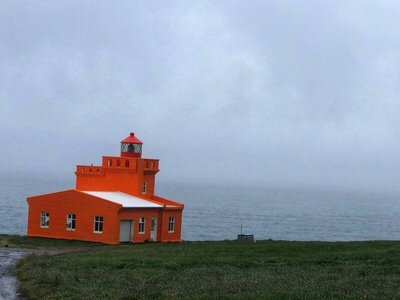

In tiny Hofsos, choices of attractions is limited, but fortunately one of the villages main sights now is a swim at the local pool. Not your everyday, average community pool, the pool at Hofsos is a gorgeously crafted infinity pool and hot pot (jacuzzi) overlooking the Hofsos harbor and nearby fjord (Hof, by the way, means harbor). Never has a swim at the community swimming center been so memorable!
Speaking of swimming pools, Icelandic people take them very seriously. Swimming culture in Iceland is similar to pub culture in England and almost every town has one, often complete with slides, diving boards and play areas. It was clear that locals go to the pool as a sense of community, to have a coffee or beer, to bask in the warm waters in the harsh weather, and have dates. If you’re on a date and are Icelandic, however, make sure to check the country’s “App of Icelanders,” which in a country of 320,000, let users “bump” phones with their date and emits a warning alarm if they are closely related. They take kissing cousins to a whole new level.
Also, attention dirty and disheveled backpackers (who…us?), if you don’t take a shower before you swim you are BREAKING ICELANDIC LAW!
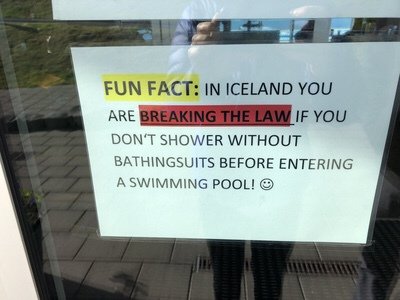
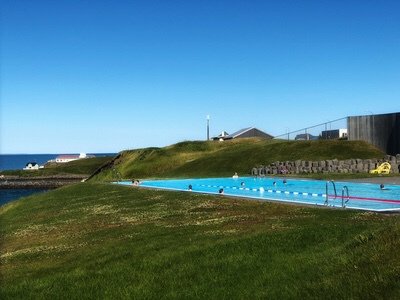
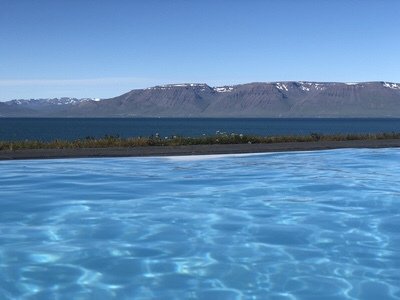

Hofsos is a fantastic place to check out the rocky sea-stack basalt columns which Iceland is known for. According to folklore, these columns were once trolls trying to pull ships from the ocean to the shore. However, these trolls were dim and went out too late in the night; when dawn broke on the horizon it turned the trolls to solid stone.
It’s interesting to see hear of Iceland’s folklore traditions. We are wondering if they rely on these tales as a way to deal with their actually quite miserable and challenging history. In addition to the Vikings, the land had a series of harsh rulers from afar, including the Norwegian and Danish empires, a series of famines of natural disasters that wiped out entire populations, and there was even a series of slave raids called the Turkish Abductions by the Ottomon pirates in 1627 when a large number of Icelanders where taken to Algiers and sold into slavery. Fortunately the country established independence in 1944, and seems to be a a much happier place.
On the lighter note, look at the two trolls below! Aww! Aren’t they’re kind cute….but seriously…where are the PUFFINS?
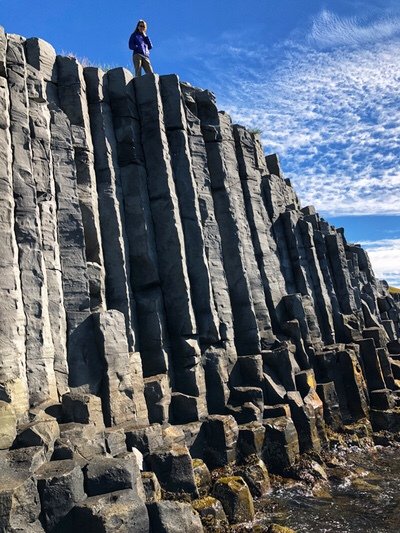
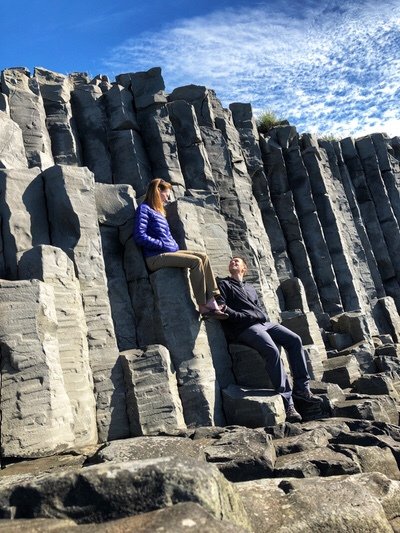

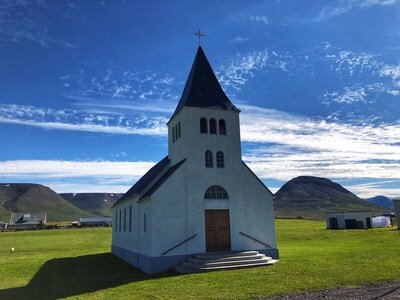
Time for more hidden gems and to find Reykafoss and its accompanying “just right” hot pot. This ultimate Iceland experience features no selfie sticks or tour buses and is only 7 km off the Ring Road. To get there from Varmahlid, driver towards Vindheimamelar on highway 752. Take a left on to highway 753 (leading you out to Vindheimamelar), cross the two wooden bridges, drive up a hill on the main road, and keep on going until you see a small pullout on the right with a hand-written (and completely missable) sign that says “Reykafoss.” Take the gravel road until you get to a parking lot and hike through some gates and the farmland a short way until you arrives at the falls. The natural hot pot is on the other side, right beside the icy river. Do both a dip into the cold river water along with your hot springs dip for the ultimate Nordic experience!
On the way out, we drove by a pasture with a herd of Icelandic horses and since we knew we had bought too many oats, Mandy used this as an opportunity to share and make some new friends. Icelandic horses are a breed specific to the country and were developed after the introduction of ponies by the Norse settlers in the 9th Century. They are smaller, sometimes pony-like, sturdier and have the ability to live in the harsh climate. Interestingly they have 5 different speeds of movement including two distinct trotting speeds, with an Icelandic name for each ‘gear’ you put your horse in.
Another stop included Víðimýrarkirkja, which is one of the few well-preserved turf churches built in 1834 and is a beautiful relic of Icelandic architecture. This is Viking-era land with a great deal of history and is well worth a visit.
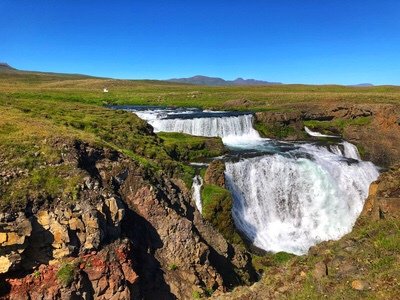


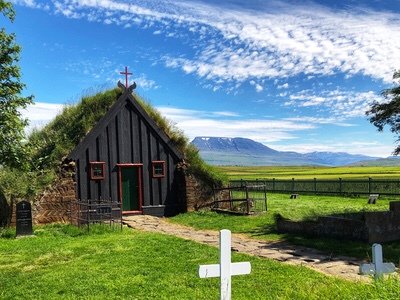
By day 5, our time in Iceland was wrapping up and we chose to spend our last night camping in the town of Akranes, located just outside of the capital Reykjavik, and about a 45 minute drive. Returning to the “hustle and bustle” of Reykjavik, which was our original plan, just sounded unappealing after spending so much time in the in peaceful natural Iceland. Akranes proved to be a pleasant detour, and good alternative to spending the night in a crowded and busy Reykjavik campground.
Akranes contained a number of surprising discoveries for us and thanks to Mr. Google, we were able to first stumble into the desiccated remains of a large ancient wood hulled ship dry-docked many decades ago in a boatyard, with all its iron bits and pieces stoically disintegrating with the passage of time.
Later we visited the two lighthouses, which you can see from across town, along the waterfront. Although it was just past closing time so we were unable to climb them. The lighthouse which is rather peculiarly/remarkably shaped like a, a-hem… “rocket ship” in the foreground is the newer of the two lighthouses built in 1947. It is available to visit. The other light house in the background was built in 1918.
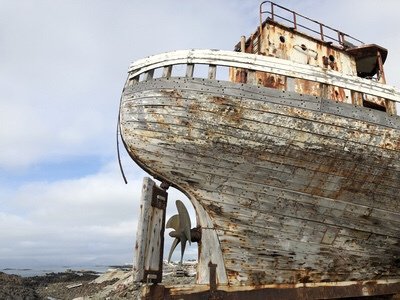
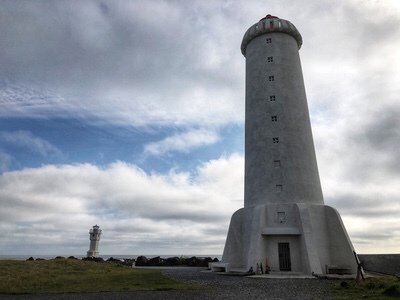
Leaving Akranes, we avoided the $12 toll road (the more speedy route to Reykjavik by about 30 minutes) by taking a 45-minute and substantially more scenic loop road detour. In Reykjavik, we made a point to stop in at the Reykjavik Eco Campsite which had a free camping equipment library to divest ourselves of all our camping kit. We hoped to make some lucky travelers day that day.
After returning our beloved rental car (we have to give a shout out to Sixt in downtown Reykjavik, we would highly recommend them… the agents were super nice and very helpful), we hoofed with our backpacks a 37-minute walk to the luggage locker located at the main bus terminal. After depositing our backpacks, we then spent the afternoon strolling Reykjavik’s very pleasant streets, averting our eyes (and noses as best we could) at any restaurants’ sandwich boards, menus, or sandwich shops in general. And speaking of sandwiches, even Subway has a presence in Reykjavik but don’t think it’s U.S. prices stay intact in Iceland… it was $11 for the cheapest sub! We did decide to small splurge of $5 for an 11 oz. (330ml) can of beer for Greg (he finally put his foot down after cutting off his beer consumption while we were in Iceland) and a very slender, not-too-satisfying hot dog, also $5.
Of course we made a stop at the iconic Hallgrimskirkja, Iceland’s second tallest structure at 74.5 meters, which can be seen from 20 miles away. In 1986, this incredibly unique church was completed after a 40-year process, which was modeled to resemble the unique basalt columns, trap rocks and glacial elements of Iceland’s landscape. In the front of the church stands Leif Erickson, a gifted statue from the U.S. in 1930 as a millennial celebration. It was only about 70 years later that Erickson was the first European to land on the Americas, naming present-day Canada Vinland. (Just another inaccuracy in Christopher Columbus’s legacy). (Fun fact…historically there were no surnames in Iceland. Erickson was the son of Eric. If Leif had been a girl, his name would have been Ericdottir. Again, Icelandic is easy!)
Luck was on our side that day, as we survived the whole day on just a cloudy note. But almost as soon as we arrived to the airport on the 55 local bus (the cheapest option at $34 for two tickets), the rain and wind returned. Our bones were chilled to the core and it was time for sunshine. Sweet sunny Sweden was calling our name.
Our TOTAL COSTS broke down as (less airfare because it was a stopover): $752.79 or $125.46/Day
Fuel (Petrol): $172.40
Rental Car (6 Days): $262.00
Camping Sites (5 Nights Accommodation): $132.06
Groceries and Propane (And HotDog in Reykjavik): $50.09
Beer: $4.42
Entrance Fees For Thermal Pools @ Hofsos pool ($19 for two) and Mytvan ($98 for two)
Left Luggage Locker @ Bus Station: $12.99
